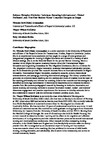Zaltman Metaphor Elicitation Technique: Revealing Link Lecturers’, Clinical Professors’, and First-Year Student Nurses’ Unspoken Thoughts as Images
| dc.contributor.author | Arunasalam, N | |
| dc.contributor.author | McGahee, T | |
| dc.contributor.author | Abraham-Settles, B | |
| dc.date.accessioned | 2018-10-16T13:12:18Z | |
| dc.date.available | 2018-10-16T13:12:18Z | |
| dc.date.issued | 2018-01-12 | |
| dc.identifier.uri | http://hdl.handle.net/10026.1/12554 | |
| dc.description.abstract |
In 2015, while on a 1-month sabbatical at the University of South Carolina Aiken, I had the opportunity to observe Dr. Betty Abraham-Settles teaching a group of six student nurses in the clinical setting. This was an insightful experience as in the United Kingdom, academics’ role as Link Lecturers is to visit practice settings to provide support to the mentors (responsible for student learning in practice) and student nurses. This invaluable experience led to the development of this collaborative research. A hermeneutic phenomenological approach using the Zaltman Metaphor Elicitation Technique was chosen for data collection. All researchers in this collaborative study agreed Zaltman Metaphor Elicitation Technique would guide the interviews while simultaneously allowing freedom of and evolution of thought. This would reveal emotions, attitudes, intrinsic values, and the behavior of the participants in practice settings. The overarching research questions were to explore the following: (a) How do you see your role as a Link Lecturer/Clinical Professor with your first-year student nurses in the practice settings? (b) As a student nurse, what do you feel your Link Lecturer/Clinical Professor does with you in the practice setting? The Zaltman Metaphor Elicitation Technique with the 11-step semi-structured interview protocol was used. This collaborative research case study provides an account of the methodological advantages and challenges in using a psychological marketing research tool for nursing research. It demonstrates how the tool enabled participants to define, describe, and evaluate their experiences to provide useful and valuable insights. | |
| dc.language.iso | en | |
| dc.publisher | SAGE Publications Ltd | |
| dc.title | Zaltman Metaphor Elicitation Technique: Revealing Link Lecturers’, Clinical Professors’, and First-Year Student Nurses’ Unspoken Thoughts as Images | |
| dc.type | journal-article | |
| plymouth.publication-status | Published | |
| plymouth.journal | SAGE Research Methods Case Health | |
| dc.identifier.doi | 10.4135/9781526439222 | |
| plymouth.organisational-group | /Plymouth | |
| plymouth.organisational-group | /Plymouth/Faculty of Health | |
| plymouth.organisational-group | /Plymouth/Faculty of Health/School of Nursing and Midwifery | |
| plymouth.organisational-group | /Plymouth/REF 2021 Researchers by UoA | |
| plymouth.organisational-group | /Plymouth/REF 2021 Researchers by UoA/UoA23 Education | |
| dcterms.dateAccepted | 2017-07-25 | |
| dc.rights.embargodate | 2019-9-20 | |
| dc.rights.embargoperiod | Not known | |
| rioxxterms.versionofrecord | 10.4135/9781526439222 | |
| rioxxterms.licenseref.uri | http://www.rioxx.net/licenses/all-rights-reserved | |
| rioxxterms.licenseref.startdate | 2018-01-12 | |
| rioxxterms.type | Journal Article/Review |


